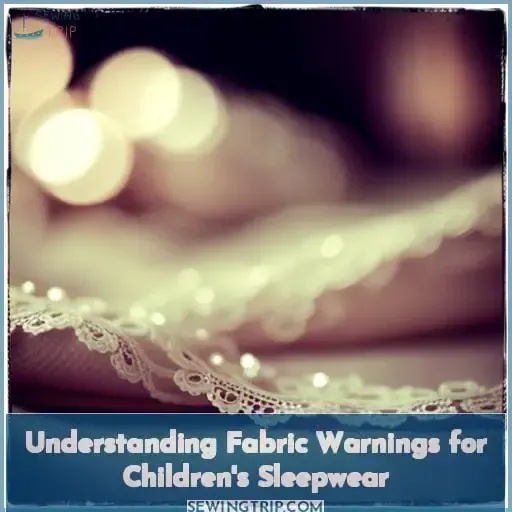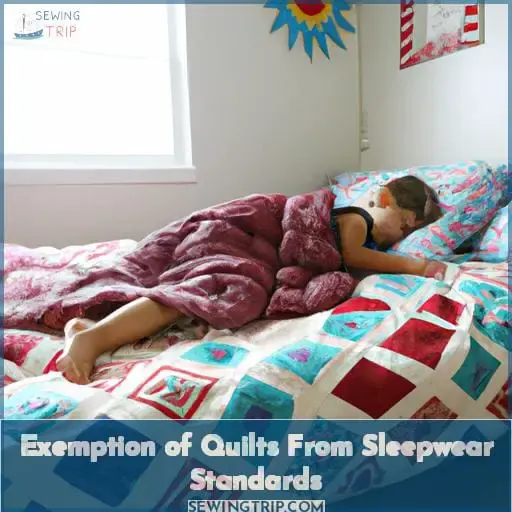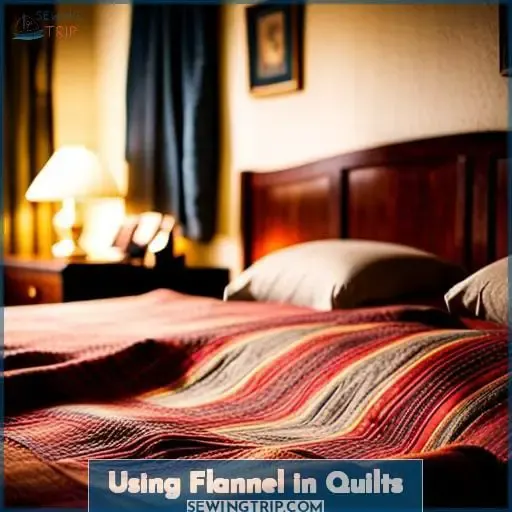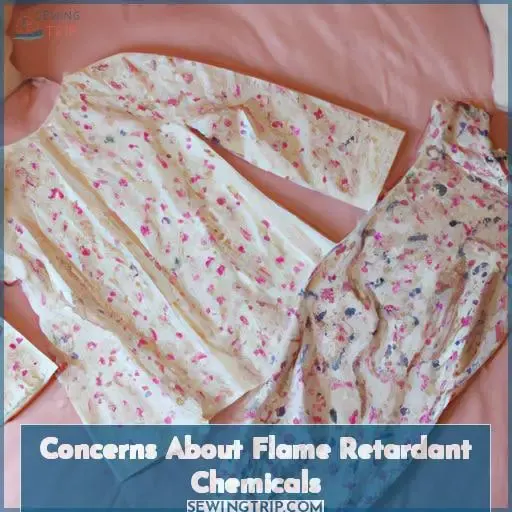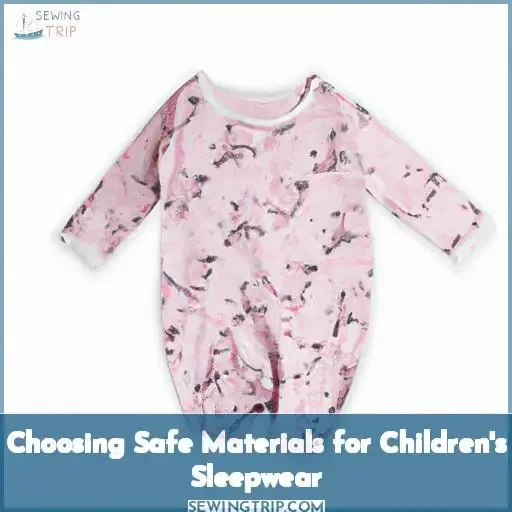This site is supported by our readers. We may earn a commission, at no cost to you, if you purchase through links.
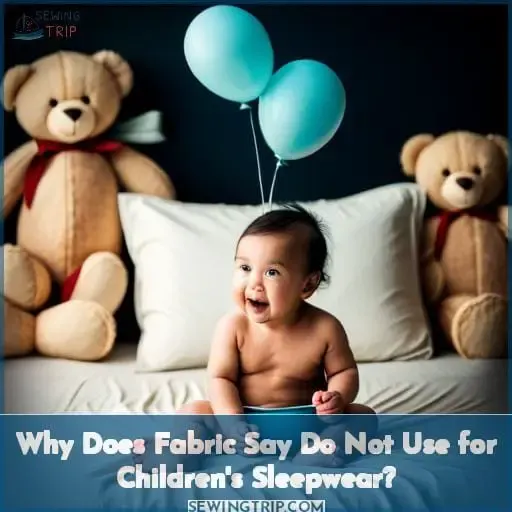 Imagine this: you’re shopping for fabric to make adorable pajamas for your little ones, but you notice a warning label that says Do Not Use for Children’s Sleepwear.
Imagine this: you’re shopping for fabric to make adorable pajamas for your little ones, but you notice a warning label that says Do Not Use for Children’s Sleepwear.
Well, my friend, it all comes down to safety regulations. In this article, we’ll delve into the reasons behind these warnings and help you understand what fabrics are safe and suitable for your children’s sleepwear.
Table Of Contents
Key Takeaways
- Indicating absence of flame retardant treatment
- Ensuring compliance with flammability safety standards
- Aligning with federal regulations for children’s sleepwear
- Prioritizing the safety of children during sleep
Understanding Fabric Warnings for Children’s Sleepwear
As a product safety expert, it’s important to understand the fabric warnings for children’s sleepwear.
These warnings typically indicate that the fabric:
- Hasn’t been treated with flame retardant chemicals
- Doesn’t meet specific safety standards for flammability
It’s crucial for parents and caregivers to prioritize flame-resistant or form-fitting sleepwear options to minimize fire risks and ensure the safety of children while they’re sleeping.
Flammability Regulations and Safety Standards for Children’s Sleepwear
Understanding the flammability regulations and safety standards for children’s sleepwear is crucial.
These regulations ensure that sleepwear meets specific safety requirements to minimize the risk of fire-related accidents.
Fabric warnings on children’s sleepwear, such as don’t use, are in place to inform consumers about potential hazards if the fabric doesn’t meet these standards.
Compliance with federal regulations helps ensure that children can safely wear their sleepwear without being at risk of burns or other injuries caused by flammable materials.
When it comes to ensuring your child’s safety during bedtime, understanding the flammability regulations and safety standards for children’s sleepwear is essential. These guidelines set forth stringent requirements for fabrics used in pajamas and nightgowns meant for young ones, guaranteeing maximum protection against fire hazards while they slumber peacefully through the night.
Federal laws mandate flame retardant treatments or snug-fitting designs in order to reduce risks associated with accidental fires from loose-fitting garments worn during sleeping hours – particularly those made from quilted fabrics like cotton or polyester blends which tend not only ignite easily but also burn rapidly when exposed even briefly near an open flame source (such as candles).
By adhering strictly according provisions outlined under current legislation governing appropriate clothing choices specifically designed keeping kids’ nighttime attire safe throughout all stages developmentally speaking; parents will be able rest easy knowing their little loved one(s) remain protected against any unexpected events involving sudden flames erupting within close proximity where these potentially dangerous products might reside just out reach unsuspecting youngsters who may unwittingly come contact them unaware dangers lurking nearby waiting strike unexpectedly catching everyone off guard leaving devastating consequences wake up next morning could have been avoided had proper precautions taken beforehand time put bedding together making sure everything met necessary criteria set forth government agencies charge overseeing compliance matters related consumer goods sold marketplace today including textiles intended primarily young individuals aged 14 years younger whom most vulnerable group regards avoiding injury death due accidental fires.
To ensure your child’s safety, it’s important to be aware of the flammability standards and regulations for children’s sleepwear. These guidelines are in place to minimize the risk of accidents caused by fire or burns.
When selecting quilt fabric for children’s sleepwear, consider whether it meets these safety standards and if any flame retardants have been applied.
Always follow fabric warnings on labels to ensure that you choose safe sleepwear options for your child.
Importance of Flame Retardant or Form-fitting Sleepwear for Children
To ensure the safety of your children while they sleep, it’s crucial to prioritize flame retardant or form-fitting sleepwear.
Flame retardant sleepwear offers significant benefits in terms of fire safety for kids.
By choosing tight-fitting pajamas made with flame retardant materials, you can minimize the risk of burns and injuries in case of a fire.
It’s essential to pay attention to fabric warnings and select safe sleepwear that adheres to proper flammability standards.
Exemption of Quilts From Sleepwear Standards
When it comes to fabric warnings for children’s sleepwear, it’s important to understand that quilts are exempt from the same safety requirements as sleepwear.
Quilts aren’t expected to come in close contact with open flames like sleepwear does.
While some flannel fabrics may have warnings stating they aren’t suitable for children’s sleepwear, using them in quilts poses no safety risk.
Different Safety Requirements for Quilts Compared to Sleepwear
You may wonder why certain fabrics say Do Not Use for Children’s Sleepwear even though they’re commonly used in quilts.
The reason lies in the different safety requirements for quilts compared to sleepwear. Quilts aren’t expected to come into close contact with open flames, unlike sleepwear. Therefore, they’re exempt from the same safety standards and can use materials like flannel without posing a risk.
So rest assured, using flannel in quilts is a safe choice.
Quilts Not Expected to Come in Close Contact With Open Flames
Quilts have an exemption from sleepwear standards because they aren’t expected to come in close contact with open flames. Unlike sleepwear, quilts serve a different purpose and don’t need to adhere to the same safety requirements.
Safety standards for children’s sleepwear focus on flame retardancy and form-fitting designs, whereas quilts prioritize comfort and warmth. It’s important to understand that using flammable fabrics like cotton in quilting doesn’t pose a safety risk when compared to children’s sleepwear.
Safety Standards Specific to Sleepwear for Children
When selecting fabric for children’s sleepwear, it’s important to understand the safety standards that specifically apply to sleepwear for children.
These safety standards aim to minimize the risk of flammability and ensure the well-being of children while they’re sleeping.
Quilts, however, are exempt from these specific safety requirements as they aren’t expected to come in close contact with open flames like sleepwear does.
Therefore, using flannel or other fabrics labeled “don’t use for children’s sleepwear” in quilts doesn’t pose a safety risk.
Using Flannel in Quilts
Using flannel in quilts is a common practice among quilters and doesn’t pose a safety risk for children.
While some flannel fabric bolts may have warnings that say they aren’t suitable for children’s sleepwear, these warnings primarily pertain to fire safety regulations specific to sleepwear.
Quilts are exempt from the same safety requirements as sleepwear and don’t come in close contact with open flames, making them safe for use with flannel fabric.
Common Practice of Using Flannel in Quilt Projects
It is a common practice to incorporate flannel fabric in quilt projects. When it comes to quilt safety, there are some important considerations regarding the use of flannel:
- Flannel can provide a soft and cozy texture for quilts, making them ideal for children.
- Using flannel in quilts doesn’t pose a safety risk like it does with sleepwear.
- Fabric warnings related to flame retardants on flannels primarily apply to sleepwear regulations.
Quilts Made With Flannel Do Not Pose a Safety Risk
If you’re considering using flannel in your quilt projects, rest assured that quilts made with flannel don’t pose a safety risk for children’s sleepwear.
Flannel is a commonly used fabric in quilting and provides softness and coziness to the quilt.
Unlike sleepwear, which has specific flame retardancy requirements, quilts aren’t expected to come into direct contact with open flames.
So go ahead and enjoy creating beautiful and safe quilts using flannel fabric!
Concerns About Flame Retardant Chemicals
When considering the use of fabric labeled “don’t use for children’s sleepwear,” it’s important to understand the concerns surrounding flame retardant chemicals.
One concern is that these chemicals may wash out after repeated laundering, rendering the fabric less effective in preventing fires.
Additionally, while flame retardant clothing can provide some protection against flames, it doesn’t necessarily protect against smoke inhalation, a common cause of fire-related deaths.
The choice of fabric composition, such as polyester versus natural fibers like cotton or flannel, can also impact safety considerations in sleepwear.
Potential for Flame Retardant Chemicals to Wash Out After Laundering
After laundering, there’s a potential for flame retardant chemicals to wash out from fabrics used in children’s sleepwear. This can affect the flame retardant efficacy of the fabric and may compromise its safety standards.
The laundering effects on flame retardants in sleepwear raise concerns about quilt safety if made with these fabrics. Fabric composition plays a crucial role in maintaining the effectiveness of flame retardants, and adherence to proper sleepwear guidelines is essential for ensuring child safety.
Ineffectiveness of Flame Retardant Clothing in Preventing Smoke Inhalation
When laundering flame retardant clothing, be aware that the potential for those chemicals to wash out exists.
Despite their use in sleepwear, flame retardant clothing may not effectively protect against smoke inhalation.
Safety concerns surrounding fabric choices and material selection highlight the need for alternatives to traditional flame retardant chemicals.
It’s essential to prioritize safety when selecting children’s sleepwear and consider other factors beyond just fire resistance.
Impact of Fabric Composition, Such as Polyester, on Safety in Sleepwear
When considering the safety of children’s sleepwear, it’s important to take into account the impact of fabric composition, such as polyester, on flame retardancy and potential concerns about the use of these chemicals.
Polyester is often used in sleepwear due to its fire-resistant properties. However, some parents have raised concerns about possible health risks associated with flame retardant chemicals used in polyester fabrics.
It’s essential to balance safety with comfort when selecting quilt materials for children’s sleepwear.
Choosing Safe Materials for Children’s Sleepwear
When choosing materials for children’s sleepwear, it’s crucial to prioritize safety by selecting fabrics that meet the necessary safety standards.
Avoid polyester and synthetic materials, as they can melt and stick to the skin when exposed to heat.
Consider flammability and safety factors in order to make informed decisions about which fabrics are suitable for children’s sleepwear.
Importance of Selecting Fabrics That Meet Safety Standards for Sleepwear
To prioritize the safety of children’s sleepwear, it’s essential for you to choose fabrics that meet the necessary safety standards and regulations.
Selecting fabrics that are flame retardant and meet specific fire safety guidelines is crucial in ensuring the well-being of your child.
By carefully considering fabric selection for their sleepwear, you can provide them with a safe and comfortable night’s rest while minimizing any potential risks associated with flammability hazards.
Avoidance of Polyester and Synthetic Materials That Can Melt and Stick to the Skin
Choose fabrics that are free from polyester and synthetic materials, as these can melt and stick to the skin, posing a safety risk for children’s sleepwear.
Polyester Concerns:
- Polyester fabrics have a higher melting point than natural fibers.
- Synthetic materials can melt when exposed to high heat or flames.
- Melting fabric can cause severe burns and injuries to the skin.
Opt for natural fibers like cotton or flame-resistant alternatives for safer sleepwear choices.
Consideration of Flammability and Safety When Choosing Materials for Sleepwea
Consider the flammability and safety factors when selecting materials for your child’s sleepwear.
As a parent, it’s essential to prioritize fire safety in choosing sleepwear materials.
Look for fabrics that are flame retardant or have undergone proper treatment to meet safety standards.
Avoid using fabrics without such precautions, as they may pose a higher risk of ignition and potential harm to your child.
By making informed choices about sleepwear materials, you can ensure your child’s safety during bedtime while promoting peace of mind.
Frequently Asked Questions (FAQs)
Are there any alternative uses for fabrics labeled do not use for children’s sleepwear?
Fabrics labeled “don’t use for children’s sleepwear” can still be used for various other purposes.
Consider using them for:
- Crafts
- Home decor
- Clothing that doesn’t require flame resistance
Explore your creativity while ensuring safety in different applications.
Can flannel fabrics be treated with flame retardants for use in children’s sleepwear?
Yes, flannel fabrics can be treated with flame retardants for use in children’s sleepwear. This treatment ensures that the fabric meets necessary safety standards and provides an added layer of protection against fire hazards.
What are the potential risks of using fabrics without flame retardants in children’s sleepwear?
Are fabrics without flame retardants safe for children’s sleepwear?
Without flame retardants, there’s a potential risk of increased flammability.
Prioritize your child’s safety by choosing fabrics explicitly labeled as flame retardant for their sleepwear.
Are there any specific guidelines or regulations for making children’s sleepwear at home?
When making children’s sleepwear at home, it’s important to follow specific guidelines and regulations to ensure safety.
Look for fabrics labeled as flame retardant and consult with fabric experts or relevant authorities for guidance.
What are some other factors to consider when choosing safe materials for children’s sleepwear, aside from flame retardancy?
When selecting safe materials for children’s sleepwear, consider factors beyond flame retardancy.
Look for fabrics that prioritize comfort and breathability to ensure a good night’s sleep.
Conclusion
Ultimately, the warning labels on fabric that say Do Not Use for Children’s Sleepwear serve as a reminder of the importance of safety regulations and standards for children’s sleepwear.
These regulations aim to protect children from the risk of fire-related accidents and ensure that sleepwear is flame retardant or form-fitting.
While quilts are exempt from these standards, fabrics such as flannel can still be used safely in quilt projects.
When choosing materials for children’s sleepwear, it’s crucial to prioritize fabrics that meet safety standards and avoid materials that can melt or stick to the skin, such as polyester.

